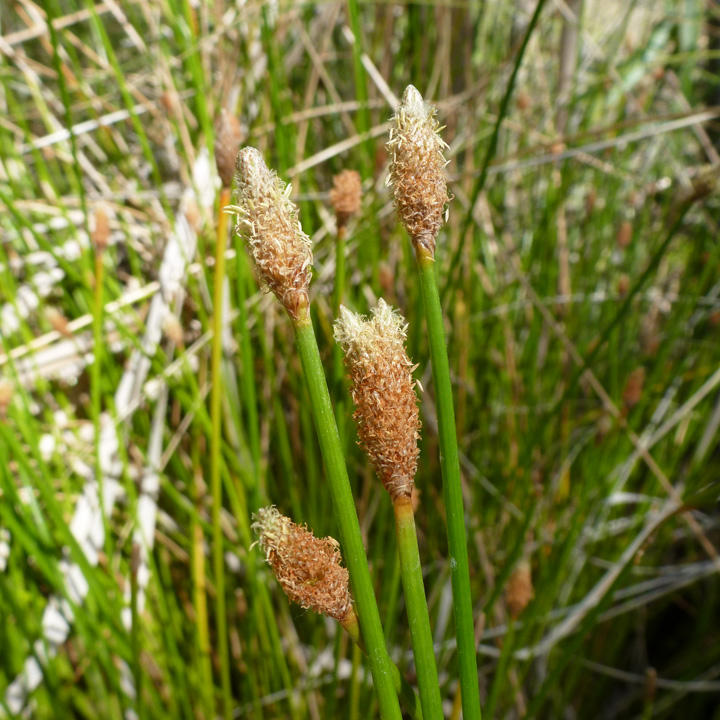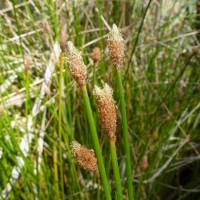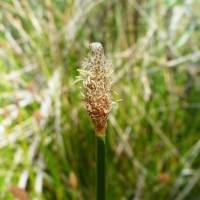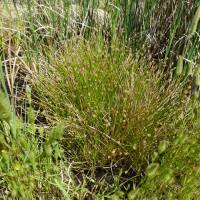Plants perennial, densely tufted or mat-forming; rhizomes mostly hidden by culms and roots, fairly long, 3 mm thick, hard, cortex persistent, longer internodes to 3 mm, scales persistent, ca. 8 mm, membranous, slightly fibrous. Culms terete, when dry with few to many blunt ridges, 10-70 cm × 0.5-2 mm, soft to firm, internally hollow with complete transverse septa 2-5 mm apart, usually evident externally except in narrowest culms. Leaves: distal leaf sheaths persistent, not splitting, proximally dark red, distally green or brown, slightly callose, papery, apex obtuse, tooth present, 0.3-1 mm. Spikelets ovoid, 6-21 × 3-4 mm, apex acute to obtuse; proximal scale amplexicaulous, entire; subproximal scale empty or with flower; floral scales appressed in fruit, 100-500+, (15-)30-40 per mm of rachilla, medium brown to colorless, midrib regions greenish to colorless, ovate, 1.5-2.5 × 1-1.5 mm, entire, apex rounded to subacute, carinate in distal part of spikelet. Flowers: perianth bristles 6-8, pale brown, medium stout, from less than 1/2 achene length to sometimes slightly exceeding tubercle, retrorsely spinulose; stamens 1; anthers dark yellow to brown, 0.6-1 mm; styles 3-fid or some 2-fid. Achenes falling with scales, dark green or medium brown, obovoid to obpyriform, biconvex or sometimes some compressed trigonous in same spikelet, lateral angles prominent, abaxial angle absent or evident, not prominent, 0.8-1.1 × 0.7-0.8 mm, neck short or absent, finely cancellate at 10-20X, sometimes finely rugulose, with 15 horizontal ridges in vertical series. Tubercles brown, pyramidal, mostly depressed, 0.2-0.35 × 0.2-0.4 mm.
Fruiting winter-fall. Fresh temporary or artificial ponds, ditches, burned savannas, swamp margins; 20-90[-2800] m; Ala., Ariz., Fla., Ga., La., Tex.; Mexico; West Indies; Central America; South America.
The taxonomy of the septate-culmed species here treated as Eleocharis montana and E. ravenelii should be evaluated. According to H. K. Svenson (1957), the type of E. montana from near Bogotá, Colombia, is the mountain extreme of the species; it has swollen culms with no visible septation.
Specimens from Acadia and St. Landry parishes, Louisiana, are intermediate between Eleocharis montana and E. montevidensis.
Common Name: mountain spikerush
Duration: Perennial
Nativity: Native
Lifeform: Graminoid
General: Densely tufted perennial, mat forming, with hidden rhizomes up to 3 mm thick, fairly long, hard, with a persistent cortex; stems terete 10-70 cm tall, 0.5-2 mm thick, soft to firm, hollow internally.
Vegetative: Leaves with upper leaf sheaths persistent, not splitting, dark red below, green or grown above, papery with obtuse apex and too, 0.3-1 mm.
Inflorescence: Ovoid spikelets, 6-21 mm by 3-4 mm with an acute to obtuse apex, upper scale stem clasping, entire, below that empty or with flower, floral scales appressed in fruit, 100-500+, 30-40 per mm of rachilla, medium brown to colorless, ovate, 1.5-2.5 mm by 1-1.5 mm, entire with a rounded to subacute apex; flowers with perianth bristles 6-8, pale brown, medium stout, from less than half the achene length to slightly longer; achenes falling with scales, dark green or medium brown, obovoid to obpyriform, some compressed three sided in same spikelet, with prominent lateral angles.
Ecology: Found in moist soils along ponds, lakes, marshes, and ditches from 200-9,000 ft (61-2743 m); flowers February-October.
Notes: Necessary to collect given the difficulty in discerning its range.
Ethnobotany: Unknown
Etymology: Eleocharis is from Greek heleos or helos, a marsh, low ground, meadow and charis, grace, beauty, hence marsh grace, while montana means of the mountains.
Synonyms: Eleocharis montana var. nodulosa, Eleocharis nodulosa
Editor: SBuckley, 2010






